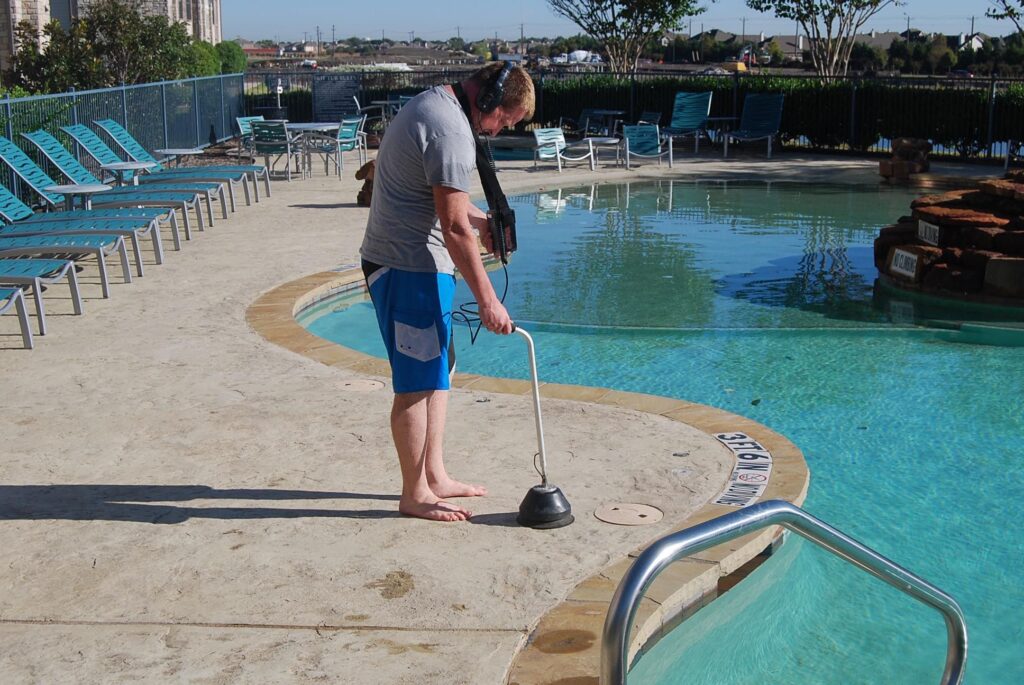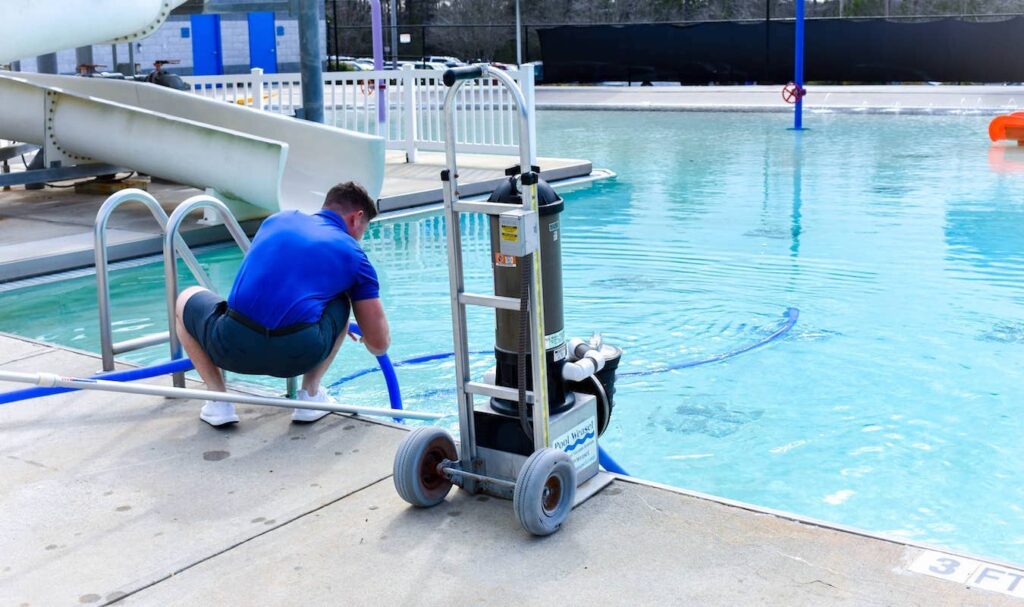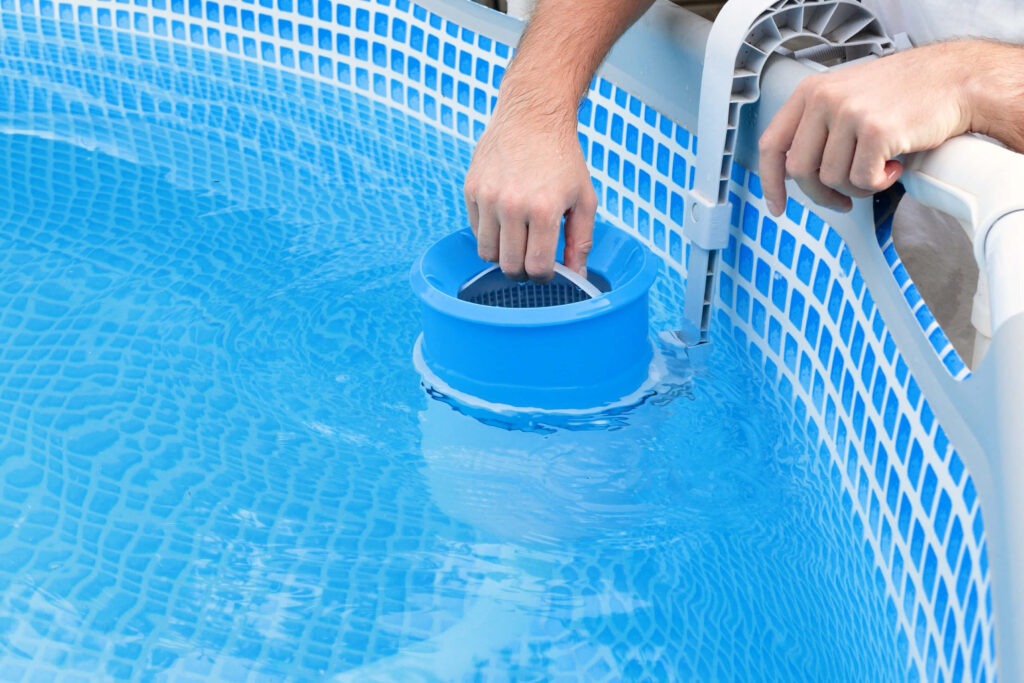If you’ve ever walked out to enjoy your pool only to notice the water level mysteriously dropping, you might be dealing with a pool liner leak. The problem? Even a tiny tear or pinhole can cost you hundreds of gallons of water and hundreds of dollars in wasted refills — not to mention the risk of damaging the surrounding structure. That’s why understanding how to detect a pool liner leak early is essential for every pool owner.
For homeowners in Henderson, Summerlin, North Las Vegas, and Paradise, the unique desert climate makes pools a year-round luxury — but also a year-round maintenance responsibility. We’ve spent years helping pool owners identify and fix leaks before they spiral into costly repairs.
Whether you’re a DIY enthusiast or prefer to leave it to the professionals, this guide will walk you through the signs, causes, and steps to finding the source of your problem.
📞 Need help right now? Call Leak Experts USA at (702) 745-5571 for fast and reliable pool leak detection.
Table of Contents
- Why Pool Liner Leaks Are a Big Deal
- Understanding Pool Liner Leaks
- Causes of Pool Liner Leaks
- Step-by-Step: How to Detect a Pool Liner Leak
- How Equipment Issues Can Mimic Liner Leaks
- When to Call a Professional
- Professional Pool Liner Leak Detection Process
- Pool Pump Repair and Leak Prevention
- Preventing Future Pool Liner Leaks
- Cost of Pool Liner Leak Repairs
- FAQs – How to Detect and Handle Pool Liner Leaks
Why Pool Liner Leaks Are a Big Deal
A pool liner isn’t just about aesthetics — it’s your pool’s waterproof barrier. Once it’s compromised, you risk:
- Higher water bills from constant refilling.
- Structural damage to the pool shell or surrounding deck.
- Increased chemical costs as treated water escapes.
- Pump and filtration strain, potentially leading to costly pool pump repair.
It’s tempting to put off repairs, but the truth is: water loss rarely stays “small.” In fact, a leak as tiny as the tip of a pen can waste thousands of gallons in a single season.
If you catch the issue early, you can often fix it without draining the pool or replacing the liner entirely. That’s why knowing how to detect a pool liner leak can make all the difference.
Understanding Pool Liner Leaks
Before you start searching for the source of water loss, it’s important to know what you’re dealing with. A pool liner leak is any puncture, tear, or seam separation that allows water to escape from the pool into the surrounding leak in my above ground.
Common signs of a pool liner leak:
- A noticeable drop in water level over a short period.
- Damp spots around the pool deck or yard.
- Wrinkles or bubbles in the liner.
- Algae growth despite regular chemical treatments (caused by fresh water diluting chlorine).
- Air in the return lines (often a sign of suction-side leaks).
In some cases, the leak may not even be in the liner — it could be caused by return line leaks or suction line issues. These plumbing problems can mimic the symptoms of a liner leak, which is why many homeowners opt for professional pool leak detection Las Vegas services rather than relying solely on guesswork.

Causes of Pool Liner Leaks
Pool liners are built to last, but they’re not indestructible. Several factors can cause a leak:
1. Age and Wear
Leak in your vinyl liners typically last 8–12 years. Over time, exposure to sunlight, fluctuating temperatures, and water chemicals can weaken the material.
2. Sharp Objects
Cleaning tools, pet claws, or dropped items can create small punctures.
3. Poor Installation
If the liner wasn’t installed properly, seams can fail prematurely, or tension points can wear down faster.
4. Ground Movement
Shifting soil — especially in regions with extreme temperatures like Nevada — can put stress on the pool walls and liner.
5. Chemical Imbalance
Incorrect pH or chlorine levels can degrade the liner material.
It’s also worth noting that a suspected liner leak might turn out to be a plumbing problem — such as return line leaks or suction line issues — which require a different repair approach. This is why an accurate diagnosis is crucial.
Step-by-Step: How to Detect a Leak in Pool Liner Leak
If you suspect a leak, the goal is to confirm it before tearing into your liner unnecessarily. Here’s a homeowner-friendly process for how to detect a pool liner leak:
Step 1: Visual Inspection
- Walk around your pool and look closely at the liner.
- Check seams, corners, and areas where the liner meets fittings.
- Look for small tears, bubbles, or areas where the liner has pulled away from the wall.
Step 2: The Bucket Test
- Fill a bucket with pool water and place it on the first or second pool step.
- Mark the water level inside the bucket and the pool’s water level outside.
- After 24 hours, compare the two.
- If the pool’s water level has dropped more than the bucket’s, you have a leak — not just evaporation.
Step 3: Dye Testing
- Turn off the pool pump to keep water still.
- Use a leak inspection dye (available at pool stores).
- Squirt a small amount near suspected areas — if there’s a leak, the dye will be pulled toward it.
Step 4: Feel for Soft Spots
- Gently press along the liner floor and walls.
- Soft or uneven spots may indicate water is escaping underneath, washing away the sand or base material.
Step 5: Rule Out Equipment Leaks
- Check around your pump, filter, and plumbing connections for drips or dampness.
- Sometimes the issue is in the plumbing rather than the liner — requiring pool pump repair or fixing return line leaks.
By methodically following these steps, you can narrow down whether your problem is truly the liner or somewhere else in the system.
How Equipment Issues Can Mimic Liner Leaks
One of the biggest mistakes homeowners make is assuming all water loss is caused by a damaged liner. In reality, issues like return line leaks and suction line issues can produce the same symptoms.
Return Line Leaks
These occur in the plumbing that carries filtered water back into the pool. If these pipes crack underground, you’ll lose water without any visible signs.
Suction Line Issues
These happen on the side of the plumbing that pulls water from the pool to the filter. Air bubbles in the pump basket or cloudy return jets can point to this problem.
Pool Pump Leaks
Sometimes, the water loss is due to a failing seal or gasket in the pump — a problem solved with timely pool pump repair rather than expensive liner replacement.
💡 Tip: If you’ve tested your liner but can’t find any visible tears, it’s wise to call a professional for pool leak detection Las Vegas services before committing to major repairs.
When to Call a Professional
While DIY detection can be effective, there are situations where a trained technician is the best option:
- The leak is small but persistent, and you can’t pinpoint the location.
- You’ve already tried patching, but water loss continues.
- Signs point to my above ground pool and underground plumbing issues.
- You want a non-invasive solution that avoids unnecessary liner removal.
We use advanced detection tools — including acoustic listening devices, pressure testing, and underwater inspection — to identify leaks with pinpoint accuracy. This ensures you fix the exact problem the first time, saving time, money, and frustration.
📞 Call (702) 745-5571 today and let a certified pool leak specialist restore your pool’s efficiency and safety.

Professional Pool Liner Leak Detection Process
When DIY methods don’t give you a clear answer, professional inspection becomes the most efficient option. We’ve developed a proven process for accurate leak inspection without causing unnecessary damage to your pool.
Step 1: Preliminary Assessment
We start by asking about your pool’s history — recent repairs, chemical levels, or noticeable changes in water usage. This helps us narrow down possible problem areas.
Step 2: Water Level & Pressure Testing
We measure water loss rates and use pressure tests on plumbing lines to rule out return line leaks or suction line issues.
Step 3: Underwater Inspection
Our certified divers inspect the liner for tears, seam separations, and weak spots. We use specialized underwater cameras and dye to confirm the exact location of leaks.
Step 4: Non-Invasive Location Methods
In cases where the leak is in the plumbing, we use acoustic listening equipment to detect underground water movement — avoiding unnecessary excavation.
Step 5: Repair Recommendation
Once we identify the issue, we provide clear, upfront repair options — from patching a small liner tear to performing a pool pump repair if equipment is the culprit.
Pool Pump Repair and Leak Prevention
It’s easy to blame the liner when you notice water loss, but sometimes the root cause is your pump or filtration system. Neglecting these components can put unnecessary strain on your pool and cause symptoms similar to a liner leak.
Signs Your Pump Needs Repair:
- Visible drips around the pump housing.
- Unusual noises during operation.
- Low water pressure in return jets.
- Air bubbles coming from the returns.
If these symptoms are present, pool pump repair should be your first step before replacing a liner. Addressing pump issues early not only saves water but also extends the life of your entire pool system.
💡 Pro Tip: Combining pump maintenance with regular pool leak detection Las Vegas inspections can dramatically reduce the chances of recurring water loss.

Preventing Future Pool Liner Leaks
Once your pool is back in shape, keeping it that way comes down to regular care and a few preventative measures.
1. Monitor Water Chemistry
Maintain proper pH and chlorine levels to prevent liner deterioration.
2. Avoid Sharp Objects
Be careful with cleaning tools, toys, and accessories that could puncture the liner.
3. Schedule Seasonal Inspections
A quick check in spring and fall can catch issues before they escalate.
4. Protect the Liner During Winter
Even in warmer climates, covering the pool during periods of non-use helps prevent debris damage.
5. Check Plumbing Regularly
Watch for early signs of return line leaks or suction line issues, which can worsen liner strain over time.
Taking a proactive approach ensures you won’t need to revisit the same costly problem year after year.
Cost of Pool Liner Leak Repairs
The cost of fixing a pool liner leak depends on the size, location, and whether additional equipment repairs are needed.
Small Patch Repairs
- Cost: $150–$350
- Suitable for small tears or seam separations.
- Usually completed in a single visit without draining the pool.
Full Liner Replacement
- Cost: $2,500–$5,500
- Recommended if the liner is aged, brittle, or damaged in multiple spots.
Plumbing-Related Leaks
- Cost: $400–$1,200
- Applies to return line leaks, suction line issues, or pool pump repair work.
💡 Money-Saving Tip: Early detection — either through DIY steps or pool leak detection Las Vegas services — can often mean the difference between a quick patch and a costly liner replacement.
FAQs – How to Detect and Handle Pool Liner Leaks
1. How long does a pool liner last?
Vinyl liners typically last 8–12 years, depending on maintenance and exposure to sunlight.
2. Can I patch a pool liner myself?
Yes, small tears can be patched with a vinyl repair kit, but for larger or hidden leaks, it’s safer to hire a professional.
3. How do I know if it’s evaporation or a leak?
Perform the bucket test — if the pool water drops more than the bucket water in 24 hours, it’s a leak.
4. Will insurance cover a pool liner leak?
Coverage varies by policy, but most insurers see liner wear as a maintenance issue, not a covered loss.
5. Can a leak damage my pool pump?
Yes. A leak can lower water levels and cause the pump to run dry, leading to costly pool pump repair or replacement.
Protect Your Pool Investment
Detecting and repairing a liner leak quickly is the key to avoiding excessive water bills, structural damage, and expensive repairs. By learning how to detect a pool liner leak, you can take proactive steps to protect your pool — and your wallet.
We pride ourselves on fast, accurate leak inspection and reliable repairs. From spotting a small tear to fixing suction line issues or performing a full pool pump repair, our certified technicians handle it all.
📞 Call us today at (702) 745-5571 or book online for expert pool leak detection Las Vegas homeowners trust. Serving with precision, care, and the experience to get the job done right. Follow us on Instagram for regular updates!

